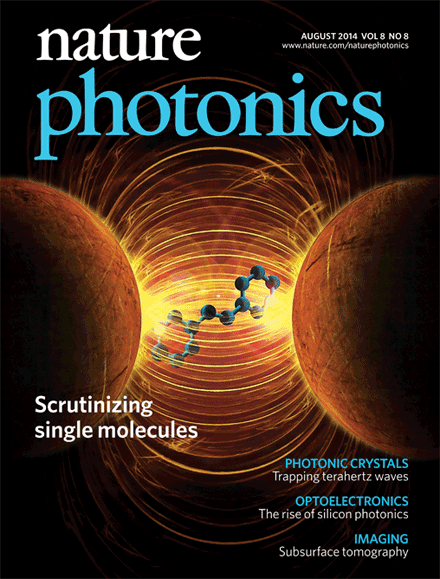Capturing the motion of a single molecule in real time as it oscillates from one quantum state to another
September 18, 2014

(Credit: Nature Photonics)
UC Irvine chemists have scored a scientific first: capturing moving images of a single molecule as it vibrates and shifts from one quantum state to another.
The groundbreaking achievement, led by Ara Apkarian, professor of chemistry, and Eric Potma, associate professor of chemistry, could lead to new insights in developing quantum computers.
It also moves researchers a step closer to viewing the molecular world in action — being able to see the making and breaking of bonds, which control biological processes such as enzymatic reactions and cellular dynamics.
The August issue of Nature Photonics features this breakthrough as its cover story.
“Our work is the first to capture the motion of one molecule in real time,” Apkarian said. While still images of single molecules have been possible since the 1980s, recording a molecule’s extremely rapid movements had proven elusive.
To track its activity and record measurements over the course of an hour, the researchers used precisely tuned, ultrafast lasers and microscopes and equipped the molecule with a tiny antenna consisting of two gold nanospheres to detect movements.
When the many repeated measurements were averaged, an astonishing finding emerged: the molecule was actually oscillating from one quantum state to another.
The scientists have produced a movie in which a small, glowing dot appears to emit pulses of bright light. “That’s the light broadcast from the antenna every time the molecule completes a cycle of its vibrational motion,” Apkarian said. “The bond moves at a rate of 1013 cycles per second — a million, million times 10 cycles in one second.” Making the movie was like freeze-frame photography with a very fast flash and repeating the measurement over and over again.
Produced by Science Nation, National Science Foundation
Seeing a molecule as it moves is “essential to a deeper understanding of how it forms and breaks chemical bonds,” Potma said. “The aim of the present experiment was to demonstrate that we can capture a molecule in motion on its own timescale.”
The next and even more ambitious goal is to acquire moving images of molecules in their natural environment without tethering them to an antenna. “Ultimately, we’d like to be able to [examine] a molecule … as it’s undergoing chemistry,” Apkarian said.
He and Potma are members of the Center for Chemistry at the Space-Time Limit, a research entity funded by the National Science Foundation that involves about 60 scientists on five campuses.
Abstract of Nature Photonics paper
The motion of chemical bonds within molecules can be observed in real time in the form of vibrational wave packets prepared and interrogated through ultrafast nonlinear spectroscopy. Such nonlinear optical measurements are commonly performed on large ensembles of molecules and, as such, are limited to the extent that ensemble coherence can be maintained. Here, we describe vibrational wave packet motion on single molecules, recorded through time-resolved, surface-enhanced, coherent anti-Stokes Raman scattering. The sensitivity required to detect the motion of a single molecule under ambient conditions is achieved by equipping the molecule with a dipolar nano-antenna (a gold dumbbell). In contrast with measurements in ensembles, the vibrational coherence on a single molecule does not undergo pure dephasing. It develops phase fluctuations with characteristic statistics. We present the time evolution of discretely sampled statistical states, and highlight the unique information content in the characteristic, early-time probability distribution function of the signal.